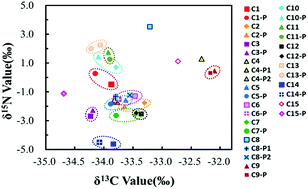Linking opiate metabolites to heroin through gas chromatography-combustion-isotope ratio mass spectrometry†
Abstract
A practical gas chromatography-combustion-isotope ratio mass spectrometry (GC-C-IRMS) technique was developed for tracing seized heroin through heroin abusers' opiate metabolites. In this approach, morphine is the target that links an abuser's opiate metabolites to the seized heroin through measurements of their δ13C and δ15N. To analyze morphine in real samples, hydrolysis of the sample, solid phase extraction, and reaction of morphine with N,O-bis(trimethylsilyl) trifluoroacetamide to form bis(trimethylsilyl)morphine are required before GC-MS for quantitation or before GC-C-IRMS for obtaining δ13C and δ15N of bis(trimethylsilyl)morphine. The δ13C signals of bis(trimethylsilyl)morphine are linear between 3100 and 33 000 mV. On the other hand, the δ15N signals of bis(trimethylsilyl)morphine are linear between 310 and 1085 mV. The practicality of this GC-C-IRMS approach was validated using the analysis of abusers' urine and heroin samples seized by law enforcement officers in Taiwan. Among all 15 actual cases (except cases 4, 8, and 15), a strong association was noted between the seized heroin and the abusers' urine samples based on the δ13C and δ15N of morphine. The results obtained from this practical GC-C-IRMS approach provide information for law enforcement officers to disclose criminal plots and for judges to reach an accurate verdict.



 Please wait while we load your content...
Please wait while we load your content...